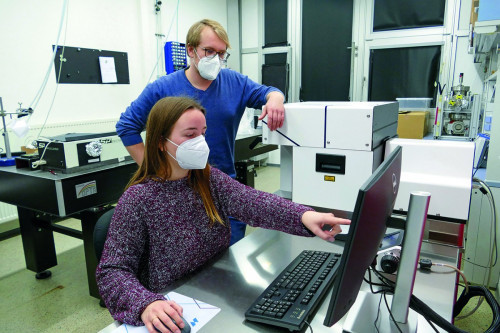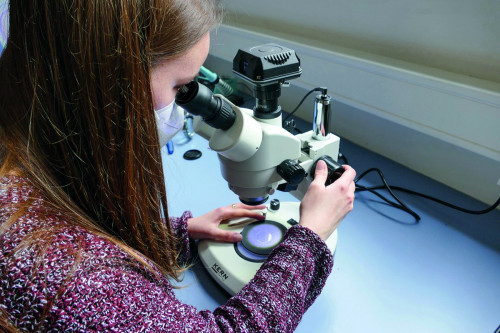An interdisciplinary team at Münster University of Applied Sciences is conducting research at the interface between quantum technology and conventional electronics. In connection with its annual motto of sustainability, the university presented this and many other activities and projects in the field of future technologies in mid-March 2022.
An interdisciplinary team at Münster UAS is conducting research at the interface between quantum technology and classical electronics. In connection with its annual motto of sustainability, the university presented this and a wide range of other activities and projects in the field of future technologies in mid-March 2022.
 The current preliminary tests focus on a very special 3D printer: a microfabrication system. Physics engineer Lara Lindloge and electrical engineer Jens Pogorzelski talk about itThestructures that doctoral student Lara Lindloge has printed on a coin-sized glass plate are barely visible to the naked eye. Only under a microscope do their main players become visible: nanodiamonds with a so-called nitrogen-vacancy center, or NV center for short. The tiny crystals are the focus of the new research project 'Optical waveguides and CMOS interface for quantum sensors with NV centers' (OCQNV) at Münster University of Applied Sciences. Under the leadership of Prof. Dr. Peter Glösekötter from the Department of Electrical Engineering and Computer Science and Prof. Dr. Markus Gregor from the Department of Physical Engineering, a team of six is investigating how quantum-based current sensors based on these special diamonds can be connected to conventional electronics. The Federal Ministry of Education and Research (BMBF) is funding the research work on the Steinfurt campus with around €1.5 million.
The current preliminary tests focus on a very special 3D printer: a microfabrication system. Physics engineer Lara Lindloge and electrical engineer Jens Pogorzelski talk about itThestructures that doctoral student Lara Lindloge has printed on a coin-sized glass plate are barely visible to the naked eye. Only under a microscope do their main players become visible: nanodiamonds with a so-called nitrogen-vacancy center, or NV center for short. The tiny crystals are the focus of the new research project 'Optical waveguides and CMOS interface for quantum sensors with NV centers' (OCQNV) at Münster University of Applied Sciences. Under the leadership of Prof. Dr. Peter Glösekötter from the Department of Electrical Engineering and Computer Science and Prof. Dr. Markus Gregor from the Department of Physical Engineering, a team of six is investigating how quantum-based current sensors based on these special diamonds can be connected to conventional electronics. The Federal Ministry of Education and Research (BMBF) is funding the research work on the Steinfurt campus with around €1.5 million.
- This is how Jens Pogorzelski, also a doctoral student in the project, describes the size ratio of the diamond structures. The current preliminary tests are therefore focusing on a very special 3D printer, a so-called microfabrication system, which has recently been installed in the Laboratory for Quantum Technology. The physics engineers involved are initially using it to print the individual components that are to be used for the optical control of NV centers. These include lenses, waveguides and diffraction gratings, for example. The electrical engineers focus on the electrical control of the components and also integrate a microwave antenna. "We are developing interfaces for two application scenarios: Sensor-on-a-chip, i.e. the integration of the sensor module on a microchip, and sensor-on-a-tip, in which the diamond is connected to the sensor module via an optical fiber," explains Pogorzelski.
The finished magnetic field sensor modules then work as follows: The carbon lattice of the diamond, which has been modified by nitrogen atoms, fluoresces red when it is irradiated with green light. The stronger the electric current, the stronger the magnetic field generated and the lower the red fluorescence. The advantage of the sensors is that they measure with high precision and are only addressed optically via light - electrical cables are therefore not necessary. "Nanodiamonds are now well researched. The challenge is to find clearer applications for them. The interface technology that we are developing in the project fills this gap," summarizes Gregor. It is conceivable, for example, to use these magnetic field sensors developed at the end of a glass fiber to examine cells in a biocompatible manner. Current measurement in electric cars to determine their remaining range is also a possible application scenario. "Conventional current sensors use a so-called shunt resistor, but this heats up considerably and leads to losses, ageing and measurement inaccuracies. If, on the other hand, you measure the change in the magnetic field of a current-carrying conductor, you can draw conclusions about the current without a shunt resistor," explains Glösekötter.
 The structures printed on a glass plate only become visible under a microscope: nanodiamonds with a so-called nitrogen-vacancy centerThelink between research and teaching is an important concern for Glösekötter and Gregor. Last winter semester, for example, the NV centers in diamonds were the subject of the 'Embedded Systems' course at the Department of Electrical Engineering and Computer Science. The Master's students were asked to develop an embedded system, i.e. a combination of hardware and software, around this technology. A group led by electrical engineering student Julian Teuber, for example, built a magnetic field measuring device in which an optical fiber connects the diamond to the electronics. "The first measurements have basically worked, but we still have to calibrate the device," reports Teuber. "The task was a real challenge for us, but it was fun to work on a current research project." His enthusiasm for the topic continues - the student has recently joined Glösekötter's laboratory as part of the parallel project 'Room Temperature Quantum Sensors for Electromobility' (RaQuEl) and is planning his Master's thesis in the field of quantum sensor technology.
The structures printed on a glass plate only become visible under a microscope: nanodiamonds with a so-called nitrogen-vacancy centerThelink between research and teaching is an important concern for Glösekötter and Gregor. Last winter semester, for example, the NV centers in diamonds were the subject of the 'Embedded Systems' course at the Department of Electrical Engineering and Computer Science. The Master's students were asked to develop an embedded system, i.e. a combination of hardware and software, around this technology. A group led by electrical engineering student Julian Teuber, for example, built a magnetic field measuring device in which an optical fiber connects the diamond to the electronics. "The first measurements have basically worked, but we still have to calibrate the device," reports Teuber. "The task was a real challenge for us, but it was fun to work on a current research project." His enthusiasm for the topic continues - the student has recently joined Glösekötter's laboratory as part of the parallel project 'Room Temperature Quantum Sensors for Electromobility' (RaQuEl) and is planning his Master's thesis in the field of quantum sensor technology.
For those responsible at the university, application-oriented research has the following background: For many decades, German companies have been driving innovation, securing the prosperity of the export nation and providing international impetus for more sustainable value creation. In some key future technologies, however, Germany now plays a minor role in global competition. A social effort is needed to change this. Münster University of Applied Sciences has therefore addressed this challenge in its current university development plan. As a university of applied sciences, it aims to continue contributing to strengthening the attractiveness of Germany as a technology and business location in the coming years with its high-profile technical departments and research institutes, among other things.-dir/vti-
References and links:
https://www.fh-muenster.de/eti/personen/professoren/gloesekoetter Prof. Dr. Peter Glösekötter
https://www.fh-muenster.de/phy/professorInnen/gregor.php Prof. Dr. Markus Gregor
https://www.fh-muenster.de/eti/personen/professoren/gloesekoetter/index.php?anzeige=projekt&pr_id=1129Projektseite OCQNV
https://www.fhmuenster.de/hochschule/aktuelles/news/index.php?newsId=2376 Press release from July 16, 2021 on the 'RaQuEl' project: Measuring electrical currents precisely and quickly


